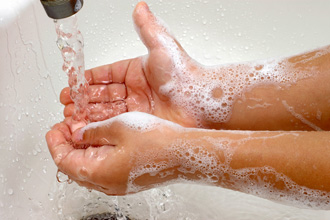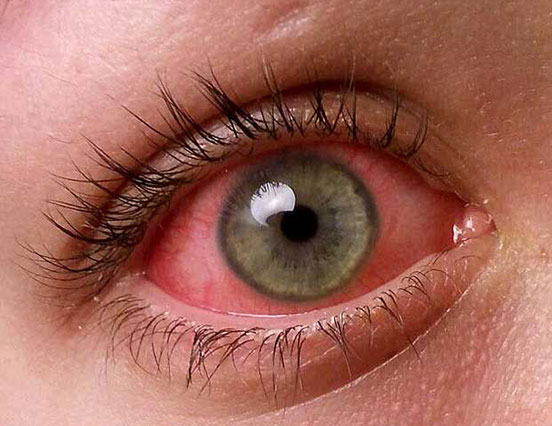“Pink eye” is a term that may sound scary, but this common eye problem typically is easily treated and, with a few simple precautions, can often be avoided.
Anyone can get pink eye, but preschoolers, schoolchildren, college students, teachers and daycare workers are particularly at risk for the contagious types of pink eye because they work closely with others in the classroom.
Here are the essential facts about pink eye (conjunctivitis) that you should know:
What Is Pink Eye?
Pink eye — also called conjunctivitis — is inflammation of the thin, clear covering of the white of the eyeand the inside of the eyelids (conjunctiva).
Although the conjunctiva is transparent, it contains blood vessels that overlay the sclera of the eye.
Anything that triggers inflammation will cause these conjunctival blood vessels to dilate. This is what causes red, bloodshot eyes.
Conjunctivitis can have several causes (see below), but many eye doctors use the term “pink eye” to refer only to viral conjunctivitis, a highly contagious infection caused by a variety of viruses.
What Causes Pink Eye?
The primary types of conjunctivitis, based on cause, are:
- Viral conjunctivitis. Caused by a virus, like the common cold. This type of pink eye is very contagious, but usually will clear up on its own within several days without medical treatment.
- Bacterial conjunctivitis. Caused by bacteria, this type of conjunctivitis can cause serious damage to the eye if left untreated.
- Allergic conjunctivitis. Caused by eye irritants such as pollen, dust and animal dander among susceptible individuals. Allergic conjunctivitis may be seasonal (pollen) or flare up year-round (dust; pet dander).
Read more about types of conjunctivitis.
Pink Eye Symptoms
No surprise: the primary symptom of pink eye is an eye that has a pink appearance. Other symptoms of pink eye depend on the type of conjunctivitis you have:
- Viral conjunctivitis. Watery, itchy eyes; sensitivity to light. One or both eyes can be affected. Highly contagious; can be spread by coughing and sneezing.
- Bacterial conjunctivitis. A sticky, yellow or greenish-yellow eye discharge in the corner of the eye. In some cases, this discharge can be severe enough to cause the eyelids to be stuck together when you wake up. One or both eyes can be affected. Contagious (usually by direct contact with infected hands or items that have touched the eye).
- Allergic conjunctivitis. Watery, burning, itchy eyes; often accompanied by stuffiness and a runny nose, and light sensitivity. Both eyes are affected. Not contagious.

Treatment Of Pink Eye
As you would expect, the treatment of pink eye depends on the type of conjunctivitis you have:
- Viral conjunctivitis. In most cases, viral conjunctivitis will run its course over a period of several days and no medical treatment is required or indicated. A home remedy of applying a cold, wet washcloth to the eyes several times a day can relieve symptoms. (Due to the highly contagious nature of this type of pink eye, be sure not to share this washcloth with others!)
- Bacterial conjunctivitis. Your eye doctor typically will prescribe antibiotic eye drops or ointments for the treatment of bacterial conjunctivitis.
- Allergic conjunctivitis. Allergy medications often can help prevent or shorten bouts of allergic conjunctivitis. Sometimes these medications must be started before allergy season or allergy flare-ups begin. Ask your doctor for details.
Often it can be difficult to tell the type of conjunctivitis you have by symptoms alone (or if some other eye problems or underlying health conditions are causing your symptoms).
Conditions associated with conjunctivitis include other eye infections, dry eyes and blepharitis. Also, bacterial conjunctivitis sometimes can lead to very serious eye problems such as a corneal ulcer, potentially causing permanent vision loss.
For these reasons, anytime you develop red, irritated eyes, you should call your optometrist or ophthalmologist immediately and schedule an eye exam.
If you wear contact lenses, remove your lenses and wear only your glasses until your eye doctor has had a chance to examine your eyes.
And if you choose to wear eyeglasses more frequently to reduce your risk of pink eye, consider high-index lenses and anti-reflective coating to make your glasses thinner, lighter and more attractive, and to eliminate distracting reflections in the lenses. Also, photochromic lenses can reduce light sensitivity associated with pink eye and protect your eyes from harmful UV radiation and high-energy visible blue light both indoors and outside. Ask your optician for details.
Read more about pink eye treatment.
Pink Eye Prevention
Now that you know the basics about viral pink eye and other forms of conjunctivitis, what can you do to protect yourself and your kids from it?

Here are 10 simple precautions you can take to significantly reduce your risk of getting pink eye:
- Never share personal items such as washcloths, hand towels or tissues.
- Cover your nose and mouth when coughing or sneezing, and avoid rubbing or touching your eyes.
- Never (EVER) share your color contact lenses or special effect contacts with friends.
- Wash your hands frequently, especially when spending time at school or in other public places.
- Keep a hand disinfectant (e.g., Purell) handy and use it frequently.
- Frequently clean surfaces such as countertops, bathroom vanities, faucet handles and shared phones with an appropriate antiseptic cleaner.
-
If you know you suffer from seasonal allergies, ask your doctor what can be done to minimize your symptoms before they begin.
- If you wear contacts, be sure to follow your eye doctor’s instructions for lens care and replacement, and use contact lens solutions properly or consider switching to daily disposable contacts.
- When swimming, wear swim goggles to protect yourself from bacteria and other microorganisms in the water that can cause conjunctivitis.
- Before showering, using a hot tub or being in water of any kind, remove your contact lenses to avoid trapping bacteria between your eyes and the lenses.
Despite these precautions, you or your child still may develop pink eye. If the problem is contagious pink eye, be considerate of others and do your part to keep the infection from spreading.
If your child is affected, tell his or her teacher about the infection so extra steps can be taken to sanitize the classroom or day care center. Also, keep your child home until the contagious stage has passed.
Your eye doctor can let you know when you or your child can again mingle with others without risk of spreading contagious pink eye — usually about three to five days after the diagnosis.
And remember: Because a red or pink eye can be a symptom of many different types of eye problems — some that can be quite serious — make sure you consult with your eye doctor.
Source: All About Vision


